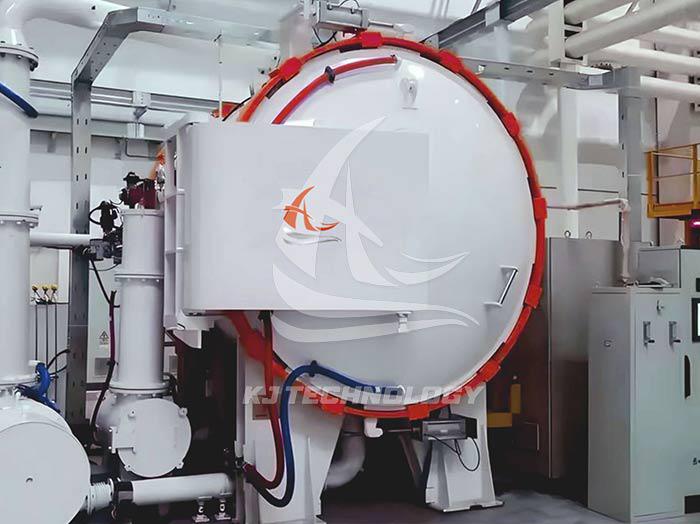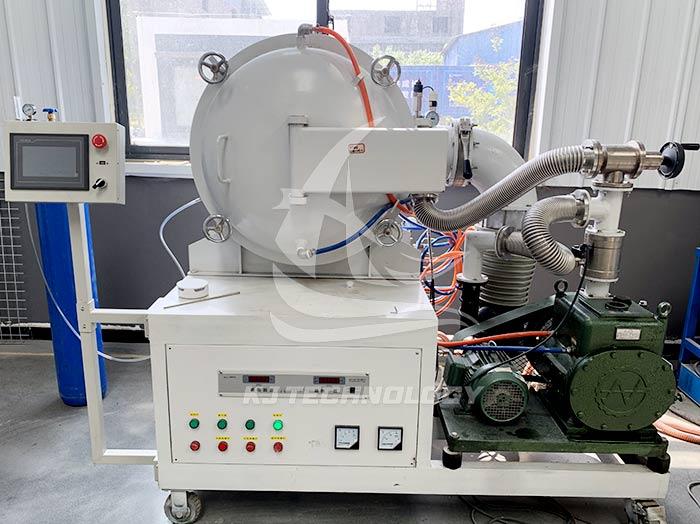Vacuum graphite high-temperature furnace for annealing workpieces
 11-06-2025 Author: KJ technology
11-06-2025 Author: KJ technology
The vacuum graphite high-temperature furnace has significant advantages in annealing workpieces, especially suitable for precision annealing processes that require high material performance and need to avoid oxidation or contamination. The following is a detailed analysis of workpieces annealed in a vacuum graphite high-temperature furnace:
1. Core advantages of vacuum graphite high-temperature furnace annealing
Anaerobic environment to prevent oxidation
Vacuum environment (maximum vacuum degree up to 5 × 10 ⁻⁶ mbar) or inert gas (such as argon, nitrogen) protection can completely isolate oxygen, water vapor, etc. in the air, avoiding oxidation or formation of oxide film on the workpiece at high temperatures, thereby maintaining the smoothness of the material surface and the purity of the chemical composition.
Typical applications: Annealed stainless steel, titanium alloys, nickel based high-temperature alloys and other easily oxidizable materials, or semiconductors and optical components that require high surface purity.
High temperature uniformity, reducing stress
Graphite heating elements have excellent thermal conductivity, which can quickly and uniformly conduct heat, making the overall temperature distribution of the workpiece consistent, reducing thermal stress caused by temperature gradients, and thus reducing the risk of cracking and deformation.
Typical applications: Annealing complex shaped workpieces (such as thin-walled parts, irregular parts) or parts that require high dimensional accuracy (such as precision molds, aviation blades).
Precise control, high process repeatability
Equipped with advanced automation control systems (such as PLC+touch screen or upper computer software), it can accurately control key parameters such as temperature, vacuum degree, heating rate, and insulation time, and support multi-stage process program settings to ensure consistency in each annealing process.
Typical application: Workpieces that require stable performance in mass production, such as automotive gears and bearing parts.
Wide adaptability of materials
Annealed metal materials (such as steel, copper, aluminum, titanium, nickel based alloys, etc.), ceramic materials (such as alumina, silicon nitride, etc.), and composite materials meet the diverse needs of different industries.
2. Typical application scenarios of vacuum graphite high-temperature furnace annealing
Annealing of metal materials
Eliminating processing stress: After the annealing machine is used to process workpieces (such as stamped parts, forgings, welded parts), residual stress is eliminated to prevent deformation or cracking during subsequent use.
Improving organizational structure: By annealing to adjust the grain size and phase composition of metals, the plasticity, toughness, or mechanical properties of materials can be enhanced. For example, annealing cold-rolled steel plates to restore their ductility.
Softening materials: Reduce the hardness of hard alloys, high-speed steel, and other materials to facilitate subsequent cutting processes.
Ceramic material annealing
Eliminating sintering stress: Annealing ceramic sintered bodies to eliminate internal stresses generated during the sintering process, improving the material's thermal shock resistance and mechanical strength.
Improving surface quality: Annealing ceramic workpieces in a vacuum environment to avoid surface oxidation or contamination, enhance surface smoothness and chemical stability.
Special material annealing
High temperature alloy: Annealing high-temperature alloy parts such as aircraft engine blades and turbine disks to eliminate hot working or welding stress and improve high-temperature performance.
Titanium alloy: Annealed titanium alloy medical implants (such as artificial joints and dental implants) to avoid oxidation layer affecting biocompatibility.
Semiconductor materials: Annealing silicon wafers, silicon carbide (SiC) and other semiconductor materials to repair lattice defects and improve electrical performance.
3. Example of Vacuum Graphite High Temperature Furnace Annealing Process (Taking Metal Workpieces as an Example)
Furnace loading: Place the workpiece on a graphite firing plate or specialized fixture to ensure sufficient clearance between the workpieces for heat conduction.
Vacuum pumping: Close the furnace door, start the vacuum system, and pump the furnace vacuum degree to the set value (such as 1 × 10 ⁻ ³ mbar).
Heating up: Heat up to the annealing temperature (such as 600-1200 ℃) according to the set program, and control the heating rate at 5-20 ℃/min (adjusted according to the material).
Insulation: Keep at annealing temperature for a certain period of time (such as 1-6 hours) to homogenize the internal structure of the workpiece.
Cooling:
In furnace cooling: Turn off the heating power and allow the workpiece to naturally cool to room temperature in the furnace (suitable for materials that are not sensitive to cooling rate).
Controlled cooling: Introduce inert gas (such as argon) to accelerate cooling, or control the cooling rate through a program (applicable to materials that require phase change control).
After the furnace temperature drops to a safe range, open the furnace door and take out the workpiece.
4. Precautions
Process parameter optimization: Adjust annealing temperature, holding time, cooling rate and other parameters according to material type, workpiece size and performance requirements to achieve the best results.
Furnace loading method: Avoid overlapping or overly dense workpieces to ensure uniform heat conduction; For thin-walled or easily deformed workpieces, specialized fixtures need to be used for fixation.
Equipment maintenance: Regularly clean the oxide scale, impurities, and volatile substances in the furnace to prevent contamination of workpieces or damage to graphite components; Check the sealing of the vacuum system to ensure that the vacuum level meets the standard.
Safe operation: Wear protective equipment (such as insulated gloves and goggles) when operating at high temperatures; The operation of the vacuum system must follow the regulations to prevent equipment damage or personnel injury caused by sudden pressure changes.








